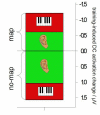Mapping perception to action in piano practice: a longitudinal DC-EEG study
- PMID: 14575529
- PMCID: PMC270043
- DOI: 10.1186/1471-2202-4-26
Mapping perception to action in piano practice: a longitudinal DC-EEG study
Abstract
Background: Performing music requires fast auditory and motor processing. Regarding professional musicians, recent brain imaging studies have demonstrated that auditory stimulation produces a co-activation of motor areas, whereas silent tapping of musical phrases evokes a co-activation in auditory regions. Whether this is obtained via a specific cerebral relay station is unclear. Furthermore, the time course of plasticity has not yet been addressed.
Results: Changes in cortical activation patterns (DC-EEG potentials) induced by short (20 minute) and long term (5 week) piano learning were investigated during auditory and motoric tasks. Two beginner groups were trained. The 'map' group was allowed to learn the standard piano key-to-pitch map. For the 'no-map' group, random assignment of keys to tones prevented such a map. Auditory-sensorimotor EEG co-activity occurred within only 20 minutes. The effect was enhanced after 5-week training, contributing elements of both perception and action to the mental representation of the instrument. The 'map' group demonstrated significant additional activity of right anterior regions.
Conclusion: We conclude that musical training triggers instant plasticity in the cortex, and that right-hemispheric anterior areas provide an audio-motor interface for the mental representation of the keyboard.
Figures








References
-
- Haueisen J, Knösche TR. Involuntary motor activity in pianists evoked by music perception. J Cogn Neurosci. 2001;13:786–92. - PubMed
-
- Scheler G, Lotze M, Braitenberg V, Erb M, Braun C, Birbaumer N. Musician's brain: balance of sensorimotor economy and frontal creativity [abstract] Soc Neurosci Abstr. 2001;27:76.14.
-
- Bangert M, Parlitz D, Altenmüller E. Cortical audio-motor corepresentation in piano learning and expert piano performance [abstract] Soc Neurosci Abstr. 1998;24:658.
-
- Pascual-Leone A, Dang N, Cohen LG, Brasil-Neto JP, Cammarota A, Hallett M. Modulation of muscle responses evoked by transcranial magnetic stimulation during the acquisition of new fine motor skills. J Neurophysiol. 1995;74:1037–1045. - PubMed
-
- Classen J, Liepert J, Wise SP, Hallett M, Cohen LG. Rapid plasticity of human cortical movement representation induced by practice. J Neurophysiol. 1998;79:1117–1123. - PubMed
Publication types
MeSH terms
LinkOut - more resources
Full Text Sources
Medical

